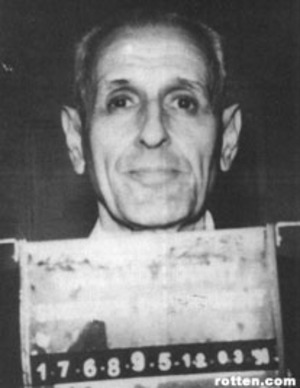Jack Kevorkian, the infamous “Dr. Death”, was released from prison June 1, 2007 after serving 8 of his 10 to 25 year prison sentence for the second degree murder of Thomas Yourk in 1998. Jack Kevorkian is the unofficial totem figure for the right-to-die movement. As a long time advocator of assisted suicide, Kevorkian claims to have helped 130 people end their lives.
The Kevorkian trial set off a hail storm of public debate over legality of physician-assisted suicide in 1998. The general population reacted as if physician-assisted suicide itself was being put on trial with many supporting (or opposing) Kevorkian, based solely on their personal views on assisted suicide. Somewhere along the way, Jack Kevorkian, the person, became lost in the political pondering.
If one word could be used to describe Jack Kevorkian it would be macabre. Kevorkian has the wonderfully sorted past, artistic talent, and mad-scientist flare of a generic nineteenth century literary villain. Early in his medical career he showed a fascination with disease and death. In 1952, Kevorkian graduated from the University of Michigan Medical School with a specialty in pathology. His first published paper, “The Fundus Oculi and the Determination of Death,” was released in 1956 and details his efforts to photograph the eyes of people in their final moment. This earned him the reputation as Dr. Death and the moniker stuck. In 1958 Kevorkian presented a controversial paper condoning medical experimentation of consenting convicts. Fearing the controversy generated by one of their residents, the University of Michigan requested that Kevorkian resign.
In 1960 Kevorkian transferred to Pontiac General Hospital. Following in 1961, he published an article in The American Journal of Clinical Pathology which describes his experiments transferring the blood of cadavers into live patients. His stent at Pontiac General Hospital didn’t last long. In 1966 he was asked to leave. He practiced as a pathologist at several hospitals during the 1970’s and attempted his own solo practice but could not maintain a stable clientele. In the latter half of the decade, after the frustrations of a failing career in medicine, Kevorkian took a 2 ½ year break to dabble in a film career, which did nothing to profit him. In the process he lost his entire life savings.
Kevorkian’s interest in film might come as a surprise for those who are not aware of Jack’s artistic abilities. Jack Kevorkian is an exceptional artist. His pieces often reflect an uneasy admiration of death and a total distain for religious ideology. His paintings often walk a fine line between being horrific and hilarious. In his work “He is Raised” Kevorkian sums up modern commercialized Easter celebrations with a surreal image of a puppet Christ being raised from an Easter egg by a group of perverse bunnies. It is a dramatic statement. If nothing else Kevorkian’s art is direct in its approach and crystal clear with its message.
In the 1980’s Kevorkian published articles about euthanasia and assisted suicide in obscure medical journals. He began to advertise his services as a “death counselor” as early as 1987. At this time the majority of his medical expertise lied in the study of disease. Most of his clinical interactions were with corpses. Aside from his residency and his military service in the 1950’s, Dr. Kevorkian had little experience with living patients and was not qualified as a counselor.
In 1989, Kevorkian built his controversial “suicide machine.” The machine consisted of $30 worth of scrap materials and hardware and was constructed on his kitchen table. Medical publications and local newspapers refused to run advertisements for the device. However, a Detroit newspaper was willing to run this advertisement in 1990:
“Applications are being accepted. Oppressed by a fatal disease, a severe handicap, a crippling deformity? Write Box 261, Royal Oak, Mich. 48068-0261. Show him proper compelling medical evidence that you should die, and Dr. Jack Kevorkian will help you kill yourself, free of charge.”
Dr. Kevorkian screened his applicants very carefully, but not in the manner which is commonly believed. Kevorkian’s patients were not given a mental health evaluation by a trained professional or a physical evaluation to determine if their claims were genuine. They were screened based on their potential press coverage and general public relations value. He turned down several applicants because they would not garner sufficient coverage for the “initial event.”
On June 4th, 1990, he found his ideal applicant. Janet Elaine Adkins, a 54 year old Michigan piano teacher, took her own life, with the assistance of Jack Kevorkian, in the back of his Volkswagen van. Janet was suffering from the beginning stages of Alzheimer disease and did not want to endure the years of progressive debilitation that comes with the disease. Her family was aware of her wishes and did not feel that the perpetually upbeat Janet was incompetent of making the decision or suffering from depression. Kevorkian was charged with the death, but a Michigan court ruled that no statute existed to punish Kevorkian for assisting with a suicide. Kevorkian was ordered not to use the machine again.
Ron Adkins, Janet’s husband, later became president of the Oregon Hemlock Society. The Oregon Hemlock Society (now called Compassion and Choices) spearheaded the right-to-die movement in Oregon which led to the Death with Dignity act of 1997 (ORS 127.800-995). The Oregon Hemlock Society has since, like many organizations that advocate PAS, tried to distance itself from Jack Kevorkian in recent years. Assistedsuicide.org sums up Jack Kevorkian’s contribution to the legalization of PAS as such. Kevorkian was never a part of the organized right-to-die movement, and public scoffed at its efforts to change the law. He was a lone ranger on this issue.”
The right-to-die movement did receive incredible momentum as a result of Jack Kevorkian’s private interests and at the very least they owe a bit of thanks for the free publicity. Of course, not all of the publicity was positive. Marjorie Wantz died with the help of Kevorkian in 1991. She was treated for psychiatric conditions on several occasions and had been taking Halcion, a drug known to impair judgment, the month before her death. Her autopsy revealed no illness or disease. Ms. Wantz claimed to be experiencing unmanageable pelvic pain, though her doctors maintain that the pain was manageable had Ms. Wantz followed their instructions. Kevorkian made no efforts to examine her pelvic area or obtain her medical records. The same year his Michigan medical license was suspended. His California license was suspended in 1993. To this date, Kevorkian does not hold a valid medical license. In 1996 Kevorkian assisted in the suicide of Rebecca Badger, a 39 year old woman who believed she had MS. Her autopsy revealed that she did not have the disease. She was a recovering alcoholic, manic depressant and had an addiction to pain medication.
The final blow to Kevorkian’s credibility came in 1998 when Kevorkian assisted in the death of Joseph Tushkowski. Tushkowski was a 45 year old paraplegic who had lost all sensation from the neck down during a hunting accident when he was 24 years of age. After Mr. Tushkowski perished from lethal injection, Kevorkian crudely removed his kidneys. He claimed that the kidneys were being removed for potential organ transplantation, but was fully aware that the kidneys could not be used by any medical establishment because proper medical protocol for screening and removal were not followed. The autopsy revealed that the kidneys were removed in such a manner as to constitute “mutilation” as no proper medical technique was used for incisions or closing arteries. Oakland County Medical Examiner L.J. Dragovic, who performed the autopsy, later said, “I don’t want to insult people who work in slaughterhouses, but this looked like it was done there.”
Kevorkian’s interest in human experimentation has always been apparent in his publications and public discussions. In his 1996 trial, Kevorkian stated for public record that he was in favor of human experimentation. He has not been shy about sharing his grand design which includes death centers where those about to undergo assisted suicide submit themselves to medical experiments for several days before finally being given a lethal injection of an untested drug or having their organs removed.
With all this information in mind it is difficult to be supportive of Jack Kevorkian’s future plans to continue his life’s work. He is a talented artist, an ingenious inventor, and a public relations master. He has brought PAS and the right-to-die to the forefront. He has given people who support PAS a martyr to look to and an umbrella to gather under. Kevorkian and his death machine have (accidentally) become the very symbol of the right-to-die movement. Regardless of his own disinterest in the legalization of PAS, he now has a reputation for standing up against those who would regulate the right of a person to terminate their own lives.







